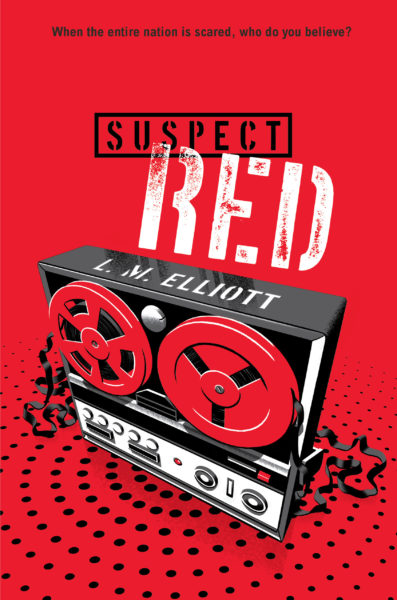Suspect Red
by L.M. Elliott

Suspect Red, by L.M. Elliott
Little, Brown Books for Young Readers 2017
Reviewed by Ed Lengel
Innumerable books and articles have been written about the post-World War II “Red Scare.” In fact, there was more than one Red Scare, and it happened in more than one place. Fear of Communism—or left-wing extremism generally, including offshoots of socialism, anarchism, and the like—hovered at the edges of popular discourse in Europe and the United States long before it sprang into the open with the Bolshevik Revolution in Russia of 1917. As Europe’s old empires crumbled in the aftermath of World War I, and Communist uprisings took place in Germany and Hungary, paranoia spread that Bolsheviks were on the edge of world takeover, or at least trying to accomplish it. These fears receded somewhat, but did not disappear in the 1920s and 1930s.
World War II created strange bedfellows, none of them more striking than the alliance between Soviet dictator Joseph Stalin, and British Prime Minister Winston Churchill, the latter a fervid anti-Communist. After 1945, the world stood far more deeply fractured than it had in 1918. Europe and Asia lay in ruins, the old colonial empires teetered on the verge of collapse, and the Soviet Union seemed stronger than ever before. In the United States, which for a time stood as the world’s only superpower, the popular mood was not triumphant, but fearful. No one knew what to expect in a terrifying new world awash in poverty, unrest, and menace by terrible new atomic weapons. The Soviet Union’s 1949 acquisition of these weapons conjured up terrifying possibilities of world extinction.
L.M. Elliott recaptures this frightening time in Suspect Red, a powerful and relevant work of young adult historical fiction that won the Grateful American Book Prize in 2018. The story takes place in 1953, when fourteen-year-old Richard Bradley discovers the implications of his father’s patriotism. Don, a World War II veteran, is an agent with J. Edgar Hoover’s Federal Bureau of Investigation. Dwight D. Eisenhower has just become president, and the Red Scare is in full swing, with Senator Joseph McCarthy and the House Un-American Activities Committee (HUAC) working at full throttle to uncover and punish alleged Communist subversives infiltrating all levels of American society.
Richard, a bookish youngster, takes no great interest in these events. He loves his father and accepts that Don is working to protect his family—and all Americans—from external threats. He just hopes to spend catching up on reading, including his favorite, Robin Hood. Nearby, however, a family from Czechoslovakia has moved into the neighborhood, with a son Vlad who is just about Richard’s age. Vlad’s parents are unconventional intellectuals and artists, and so is he. Inevitably a friendship forms between the boys; they share their love of literature and music; and Richard begins to question the settled realities of his existence as he learns more from his new friend’s perspective. Even more shocking is the discovery that some regard Robin Hood as a subversive book, and that Vlad and his family have emerged into a point of possible subversive interest to the FBI.
Since its publication in 2017, Suspect Red has taken on new meaning that the author likely never anticipated or intended, but that makes its lessons more powerful for young people than ever before. Conventional interpretations of the Red Scare suggest that it was exceptional, even bizarre, that it emanated solely from the faults of one side of the political spectrum. Ironically, a viewpoint of American exceptionalism underpins these interpretations—suggesting that Americans are prone to political paranoia, herd instincts, and the urge to oppress deviancy only at exceptional times such as the Red Scare, or when the political right holds political power. Otherwise, it seems, Americans are exceptionally tolerant and open-minded, making phenomena such as McCarthyism outrageously shocking.
The Founders knew better, which is why they established checks and balances, and other safeguards against tyrannical majorities, within the Constitution. As young people have learned since 2017, however, these protections can be inadequate. The COVID pandemic of 2020 generated not just physical lockdowns, when young people were not permitted to attend school, church, or mingle anywhere in public; but crackdowns on even verbal dissent from orthodoxies that have since proven—in many cases—to be misguided. This frightening period has generated cautionary tales magnified—now—by the oppressiveness of social media—and—academic life. The sad reality is that unorthodox political or social viewpoints are often no longer tolerated in schools: from college, and all the way down to kindergarten. The urge to self-censor for fear of public shaming—or worse, being reported to the authorities—long a hallmark of life in totalitarian societies, has come to characterize places like Europe, Canada, Australia—and—the United States.
While Suspect Red recalls a specific time in history, then, it has in many ways become more relevant than ever before. It could happen again. Perhaps it already has—and is.
Ed Lengel is an author, a speaker, and a storyteller.




